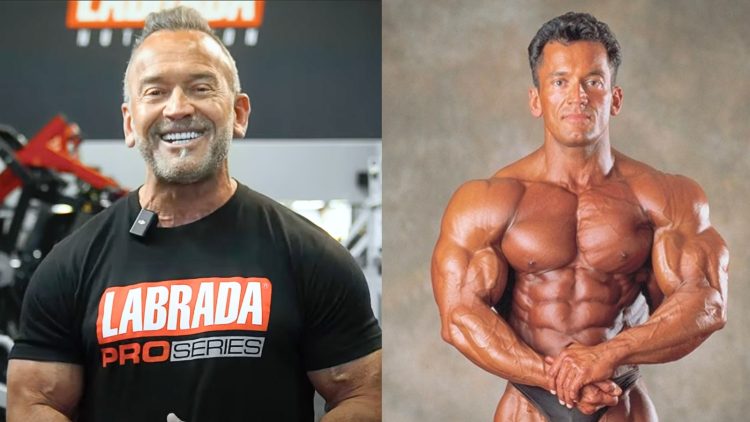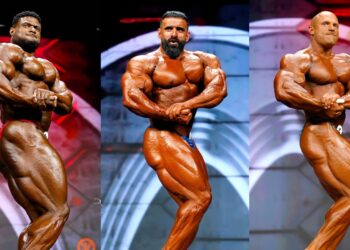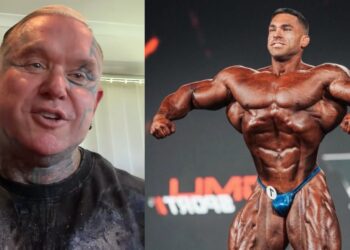Age-related muscle loss can be a challenging problem to solve, but Lee Labrada is confident he has the solution. In a recent YouTube video, Labrada explained how to build muscle after 50 with three simple and effective tips.
“If you’re over 50 and you want to know whether you can still build muscle, the answer is yes. In this video, I’m going to go over some basic things that you can start doing today to help you build muscle,” shares Lee Labrada.
As a Men’s Open bodybuilding standout from the 1980s, Lee Labrada is well-versed in sculpting a statue-esque physique. He placed in the top four at the prestigious Mr. Olympia contest for seven years, routinely testing himself against high-caliber opponents like former eight-time Mr. Olympia winner Lee Haney.
At 64 years old, Lee Labrada’s longevity is awe-inspiring, but he didn’t get to where he is by chance. For decades, he has stood by healthy eating, an active lifestyle, and resistance training all of which play an essential role in preserving muscle tissue, especially as we age.
View this post on InstagramGet Fitter, FasterLevel Up Your Fitness: Join our 💪 strong community in Fitness Volt Newsletter. Get daily inspiration, expert-backed workouts, nutrition tips, the latest in strength sports, and the support you need to reach your goals. Subscribe for free!
Bodybuilding Veteran Lee Labrada Explains How To Build Muscle Over 50 With 3 Tips
Age-related muscle loss also known as sarcopenia becomes more pervasive as we get older, though Labrada maintains that resistance training is one of the keys to reversing that dilemma.
“To build muscle you have to use resistance training and that means lifting weights. Here’s what you can expect from a good weight training program. Weight training increases muscle volume and density and that’s important because how much muscle you carry is one of the biomarkers of aging.
Typically, as we get older we experience muscle loss especially if we’re sedentary. Age-related muscle loss is called sarcopenia and quite frankly, it sucks! But the good news is that you can mitigate muscle loss as you get older if you’re willing to train with weights and eat right.”
In addition to losing muscle tissue as we age, Labrada underlined that individuals also see a reduction in bone density.
“As we age we also experience the loss of bone density. Weight training has been shown to improve bone density in individuals and can help to prevent osteoporosis as we age.”
“Because muscle tissue is metabolically intensive tissue, the more muscle you carry the more fat you burn even at rest, it keeps your metabolism higher, it helps to lower your body fat levels, and it makes you leaner and healthier.”
Tip #1 – Visit Your Doctor
Labrada believes it is safest for those over 50 years of age to inquire with their doctor before embarking on a strenuous exercise program.
“Visit your doctor and make sure you don’t have any pre-existing conditions that might preclude you from engaging in a strenuous exercise program. Once you do get the green light, then it’s time to go to the gym. Remember to ease into the weight training program allowing your body to slowly adapt to the increased loads in activity. Make sure you learn the proper form for lifting so you can safely avoid injuries.”
Tip #2 – Change Your Eating Habits
If building muscle is your goal after 50, Labrada underlines the importance of proper nutrition made up of lean protein and moderate amounts of complex carbohydrates.
“If you want to build muscle you’re probably going to have to change the way you eat. What you eat and how much you eat is really going to be important in determining how much muscle you’re going to be able to gain. So, what should you eat?
There are lots of books written on this topic but the basics are this: you want to eat a balanced diet that is high in lean protein, such as chicken, fish, egg whites, low-fat cottage cheese, and even protein shakes. You need protein to build muscle.”
Some complex carbohydrates approved by Labrada include sweet potatoes, rice, and oatmeal. With added fruits and vegetables, you’re on your way to building more muscle.
“You need to include moderate amounts of natural complex carbohydrates for energy to fuel those muscles. Healthy carbohydrates include sweet potatoes, rice, oatmeal, and those kinds of things. If you add fruits and vegetables, you’re off to the races,” shares Lee Labrada.
He adds that a multivitamin, fish oil, and creatine are also useful tools to help build muscle.
“You may also want to supplement with a good multivitamin and tablespoon of fish oil each day and some added creatine,” adds Labrada.
Tip #3 – Check Hormone Levels
Lastly, Labrada implores those over 50 to have their hormone panels checked to find out if testosterone replacement therapy might be a viable solution.
“As we get older, testosterone levels decline because testosterone is a significant factor in the ability to build muscle, you may want to have your testosterone levels checked by your doctor. If your levels are around the low-end of normal, you may want to do some research into whether testosterone replacement is right for you.”
Age-related muscle loss has been a topic of concern for those entrenched in the fitness community, including health and nutrition expert Dr. Rhonda Patrick. Due to sarcopenia later in life, Dr. Patrick believes it’s ideal for younger people to acquire as much lean muscle tissue as possible.
“Muscle mass peaks around 20 to 30, and then after that, you start to lose about 8 percent per decade until you get to 70; it’s 12 percent per decade. But strength decreases are even greater than that. So what happens when you reach the age of 50? Your anabolic resistance is starting to kick in right? You’re not being as sensitive to the protein intake.”
While resistance training for those over 50 can be ideal for muscle growth, Dr. Brad Schoenfeld, an expert in exercise and nutrition, advised against heavier loads due to joint-related issues and other possible injuries.
“If you’re training through injuries, heavy loading can be contraindicated and also particularly for the older individuals because joint-related issues as you know as people get older they get osteoarthritis and other joint-related issues where heavy loading can be very uncomfortable for them and perhaps debilitating.”
Battling against the aging process remains a top priority for Lee Labrada. The tips he has provided have been a part of his routine for decades, and judging by his youthfulness and energy levels, it’s clear they have served him well.
“Just remember that there is no substitute for doing the work that you’re going to do in the gym and following a healthy lifestyle which includes good nutrition and rest.”
RELATED: Bodybuilding Veteran Lee Labrada Shares His Back and Biceps ‘Over 50’ Workout









